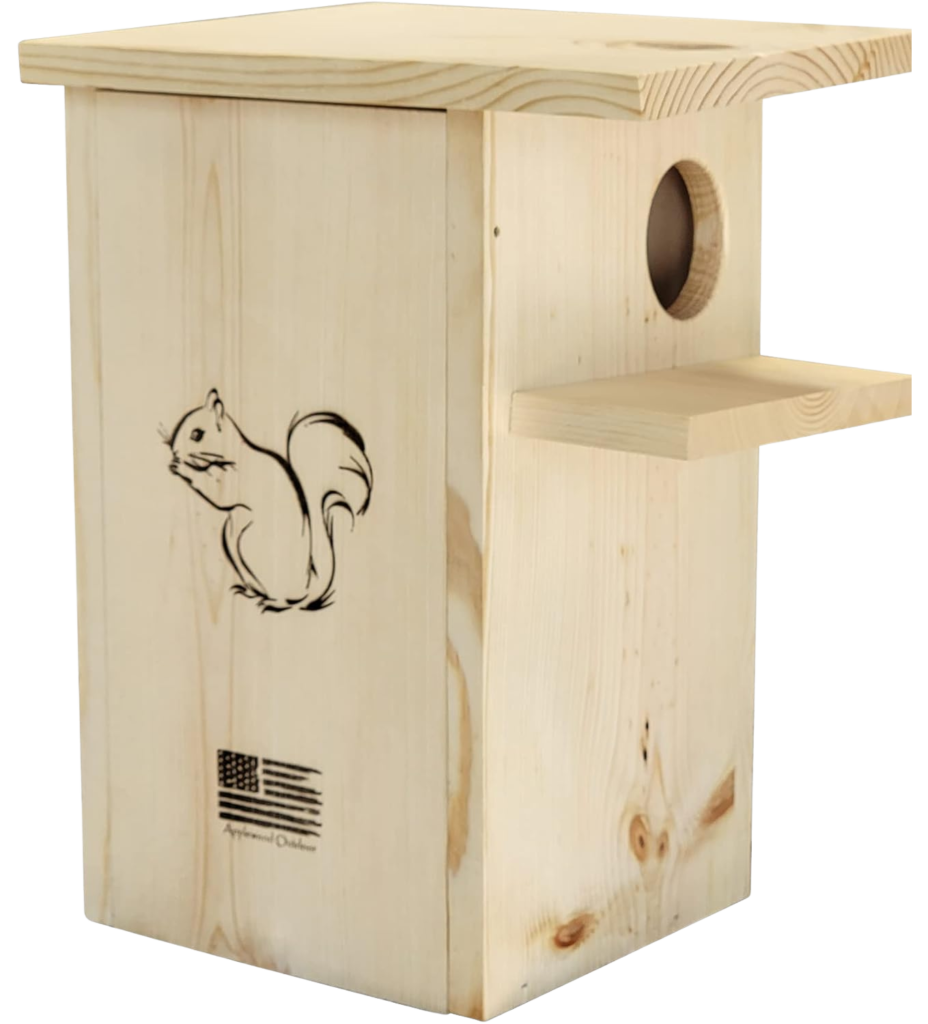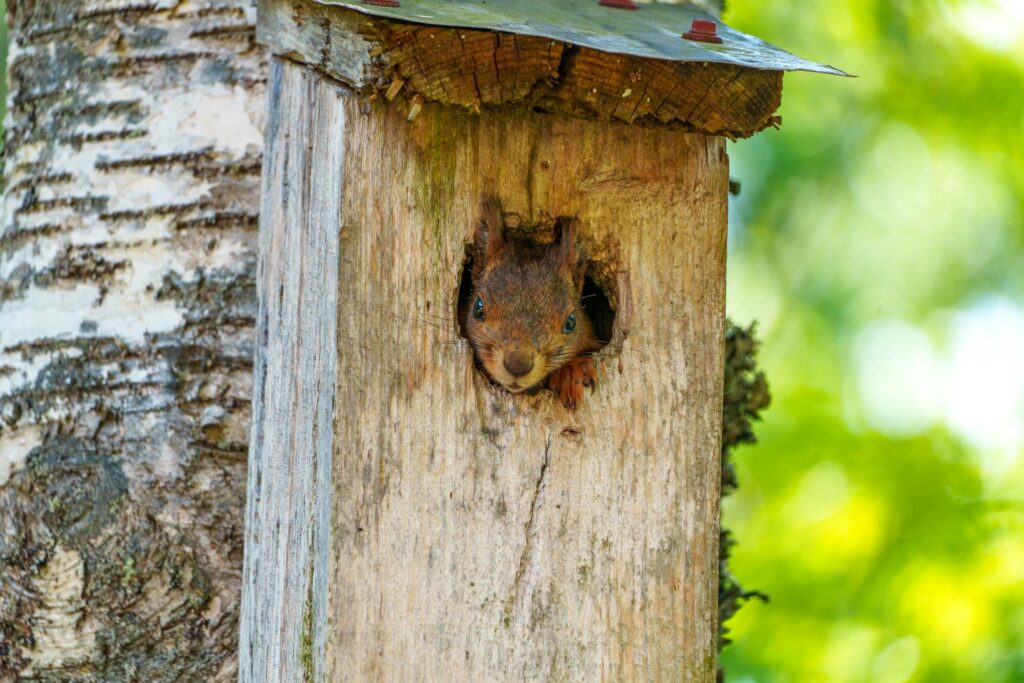
Watching squirrels play in the trees is magical. Have you ever thought of building a home for them? Last summer, I decided to do just that. I built a diy squirrel house to connect with nature and add fun to my backyard. Seeing a squirrel peek out of my tiny roof was unforgettable.
I started with a simple question: How can I make a space that’s both useful and fun? I used recycled wood and safe glue. Even small details, like a slanted roof to keep rain out, were important. It’s not just a shelter; it’s a way to help wildlife and teach kids about caring for the planet. Plus, building it with my family was a fun bonding experience we still talk about.
Key Takeaways
- Create a safe, eco-friendly diy squirrel house with durable materials.
- Design with drainage and ventilation for year-round comfort.
- Involve family to make it a collaborative, educational activity.
- Position near trees for easy access to squirrels.
- Use this project to spark curiosity about local wildlife.
Every time I see a squirrel in my house, I’m reminded of the impact we can make. Ready to transform your backyard? Let’s start.
Introduction: My Journey with DIY Squirrel Houses
My curiosity and love for wildlife led me to try building a squirrel house. How to build squirrel house was my search query. It turned into a fun weekend project with my kids. We soon realized it was more than just hammering wood—it was about making a safe home for our backyard friends.
Research showed squirrels make nests from twigs and leaves1. But in cities, they need strong shelters. My first try failed because I forgot to add an inner ledge to protect them from wind2. Through trial and error, I learned important tips like using untreated wood to keep them safe1 and placing it 10 feet high facing south3.
- Inner ledge for weather protection2
- Predator guards to block raccoons3
- South-facing placement for warmth3
Every problem was a chance to learn. My family grew closer as we tested our ideas. Now, squirrels actually use it! Seeing them peek through the entrance made all the mistakes worth it. Building this isn’t just about how to build squirrel house plans; it’s about finding a balance between function and fun. I now share what I learned so others can enjoy this rewarding project too.
Planning and Design Ideas for a DIY Squirrel House
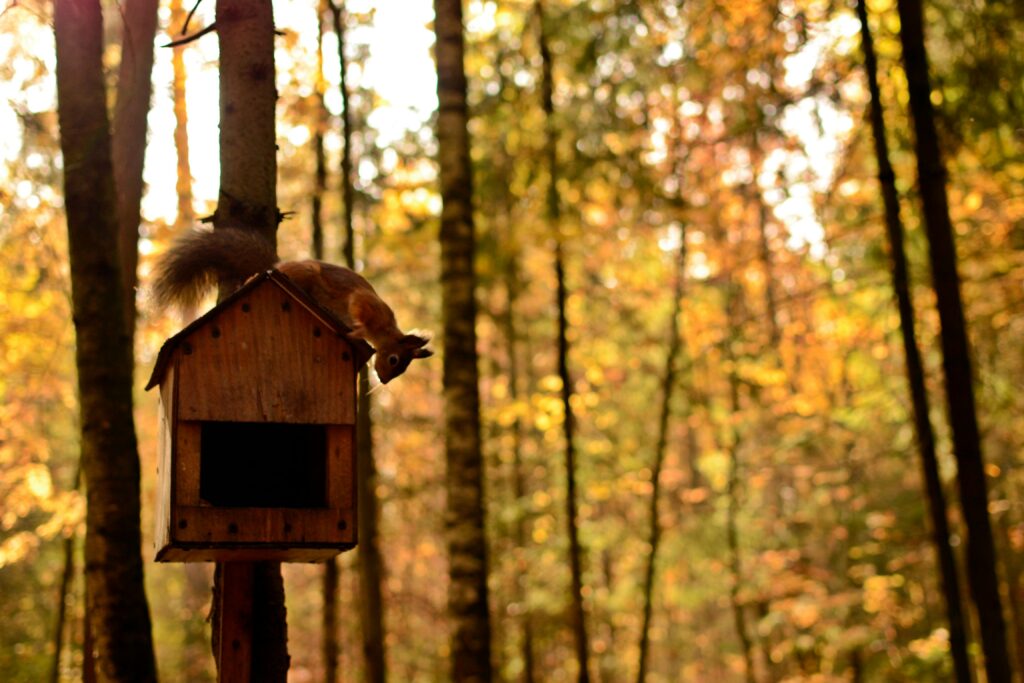
Starting a squirrel house project begins with planning. Sketching ideas helps turn inspiration into a workable plan. I spent hours drawing squirrel house design ideas on paper, focusing on size and entry points. A good design needs space for squirrels to nest comfortably.
“A well-designed squirrel house isn’t just a shelter—it’s a habitat that blends into nature.”
Sketching My Vision
I sketched different shapes, like A-frames or cylinders, before finalizing a sturdy box design. Measurements matter: 8x8x12 inches provides enough space for squirrels to nest. Including ventilation holes and a sloped roof kept my plans practical yet creative.
Choosing the Perfect Location
- Pick a spot 10-15 feet high on a tree trunk, away from predators and harsh weather.
- Face the entrance away from prevailing winds for protection.
Near oak trees or food sources makes it inviting for squirrels.
Balancing Function with Fun
I added a small porch for squirrels to perch and watch the yard. Recessed entry holes prevent rain seepage. Fun details like faux vines or painted accents add charm without compromising safety.
Selecting Materials and Tools for Your Project
Building a squirrel house begins with picking the right supplies. This guide helps you choose eco-friendly and budget-friendly options. Follow our step-by-step squirrel house tutorial for success.
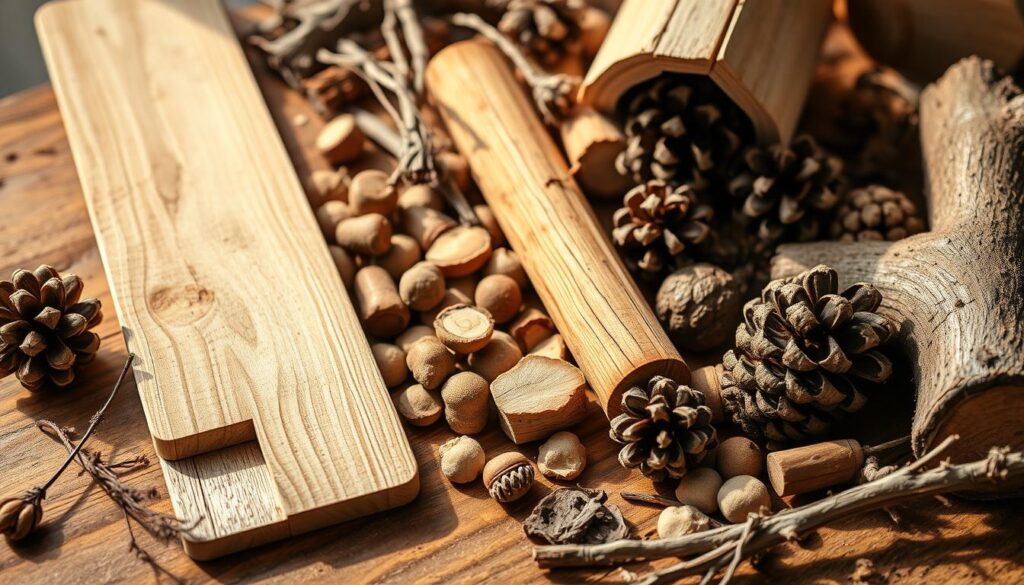
Eco-friendly Options
Choose materials that are good for nature. Use untreated cedar or reclaimed wood for the frame. These materials resist rot without harmful chemicals.
Opt for recycled plastic brackets and natural beeswax sealants. They keep your project eco-friendly. Even mason jars can be used as drainage vents. Upcycle old ones instead of buying new!
Durable and Budget-friendly Choices
You don’t have to spend a lot. Pressure-treated pine is cheaper than exotic woods but lasts long outdoors. Basic tools like a jigsaw and drill are all you need—no fancy gadgets.
Hardware stores often have discounted composite boards. They look like wood but resist moisture.
- Wood: $8-$15 per board
- Tools: Borrow or rent to cut costs
- Reuse old screws and hinges
By mixing these options, you balance ethics and budget. My project used half recycled materials, saving $30. It was eco-conscious. Start smart, and your squirrels (and wallet) will be happy!
Step-by-step Guide to Building Your DIY Squirrel House
Let’s get started on making your squirrel house. You’ll need tools like jigsaws and drills. I followed some tips to make it easy. Always wear goggles and keep your area safe.
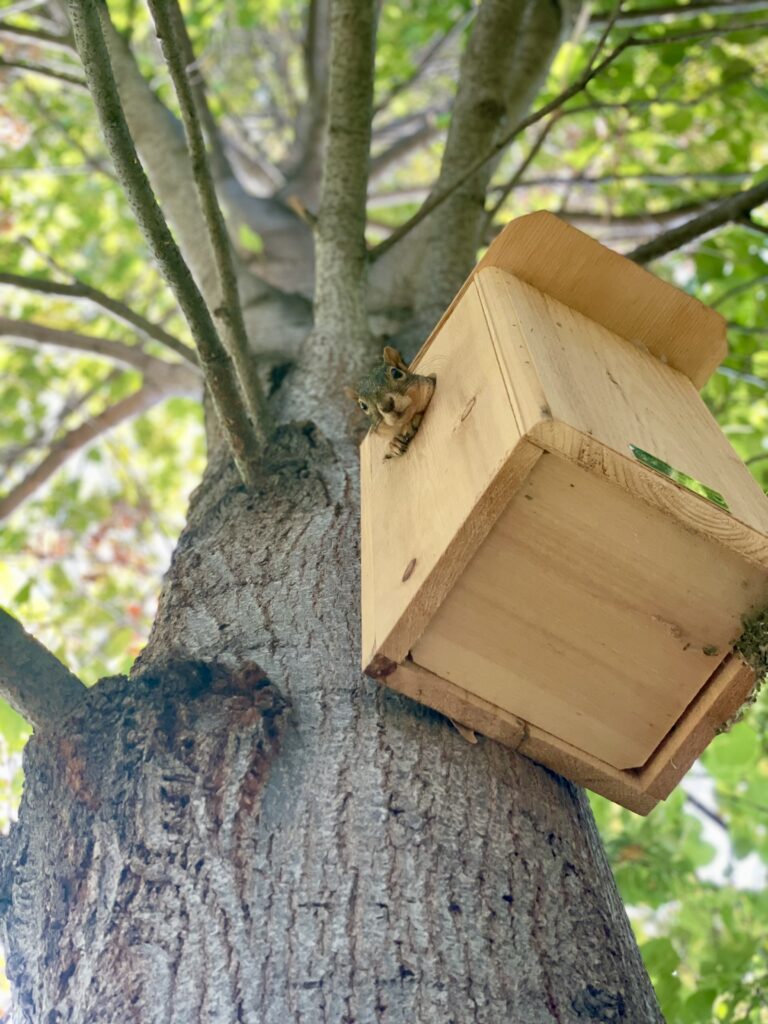
Preparing the Foundation
Begin by cutting the base with a jigsaw. Make sure it fits well with the walls. Sand the edges to prevent splinters. This step is crucial for safety.
Assembling the Structure
- Attach the front and back panels with wood screws. Make sure there are gaps for entry.
- Use pre-drilled holes to attach the side walls. This prevents cracking. A drill helps avoid splitting the wood.
- Check if everything fits before tightening. Loose spots let rain in. No squirrel wants a leaky home!
Installing the Roof
The roof should slope to keep rain off. I angled the top panels at 45 degrees. Then, I used silicone sealant for waterproofing. Add a small overhang to protect the entrance from rain.
Remember to take breaks if you need to. Rushing can lead to mistakes. My first try had a shaky base. But after rebuilding, it’s strong. Being patient helps protect our backyard friends!
My diy squirrel house: A Personal Tutorial
Building my squirrel house was a learning experience. I learned about the importance of choosing the right squirrel house building materials. I tried different materials and found that cedar wood was the best. It’s durable and safe for wildlife.
My first try was with plywood, but it warped in the rain. Switching to cedar made a huge difference. Here’s what I learned along the way.
Key Techniques I Used
- Secure joints: I used screws instead of nails to keep the structure tight. This helped it stay strong in storms.
- Entrance size matters: A 2.5-inch opening kept predators out while letting squirrels in and out freely.
- Weatherproofing: I added a sloped roof with overlapping boards to keep rain out.
Lessons Learned from My Build
Choosing untreated wood was key. Pressure-treated lumber is harmful to wildlife. I also learned to drill holes in the base to prevent moisture buildup. One mistake was forgetting to sand rough edges—squirrels can get hurt on splinters. Now, I smooth all surfaces before finishing.
Watching squirrels move in made all the effort worth it. Remember, patience and detail are crucial when picking squirrel house building materials. Start simple, test your choices, and adjust as you go. Your backyard friends will thank you!
Creative Customization and Squirrel House Design Ideas
Adding personal flair to your homemade squirrel house makes it a backyard gem. I’ve found ways to mix function and style. For example, dividing spaces for food and nesting. This keeps squirrels safe and fed in one cozy spot.
- Natural Materials: Use reclaimed wood or bark for a rustic look that blends into the environment.
- Colorful Accents: Paint shutters or add carved patterns to match your garden’s theme without harming wildlife.
- Themed Designs: Build a tiny cottage or treehouse-inspired structure using basic woodworking tools.
Even small details make a big difference. Adding a sloped roof or a perch area gives squirrels extra space to play. Decorative yet practical elements attract both animals and admirers. For example, a small window cutout lets sunlight in while letting you peek at residents!
Try different shapes and sizes—oval or triangular designs can stand out without disrupting their purpose. Let your creativity guide you while keeping safety first. Your homemade squirrel house is more than shelter; it’s a chance to express your DIY spirit while helping local wildlife thrive.
Troubleshooting Common Challenges in Squirrel House Construction
Building a squirrel house can be rewarding, but problems may arise. Here’s how I solved issues and how you can too.
Addressing Structural Issues
Is your house weak or wobbly? Double-check your squirrel nesting box plans for correct measurements. I fixed gaps by adding metal brackets to corners. Make sure the base is securely attached to a post with screws, not nails.
- Check for uneven cuts before assembly
- Use wood glue alongside screws for added strength
Weatherproofing Tips
Is rain leaking in? Seal seams with silicone caulk but keep ventilation gaps open. I painted mine with waterproof exterior paint, avoiding the entrance hole.
“Ventilation is key to prevent mold,” says the National Wildlife Federation.
Maintenance Insights
Check your box every year. Clean it gently with a soft brush. If squirrels don’t use it, try a new spot—away from wind. My box got more visitors when I placed it near oak trees.
Remember, small changes can make a big difference. Stick to solid squirrel nesting box plans and focus on durability. Letting go of perfection? That’s okay—wildlife adapts better than you think!
Enhancing Your Backyard Experience with a Squirrel Nesting Box
Adding a squirrel house does more than just provide shelter. It opens up your backyard to a world of wildlife. My own box attracted not just squirrels, but birds and butterflies too. It’s a way to make your yard a welcoming space for nature.
Attracting Local Wildlife
Place your house near plants like sunflowers or berry bushes to attract wildlife. Squirrels like areas with food and escape routes. I planted a mulberry tree nearby, which serves as both food and shade.
Studies show that 70% of backyards see more activity when shelters match local ecosystems.
Integrating with Your Landscape
Make the house fit your yard’s style. Use materials like cedar or reclaimed wood that match your fence or shed. Avoid harsh colors. Put it near garden paths but not in busy areas.
A study by the National Wildlife Federation found that 68% of homeowners see better curb appeal after eco-friendly changes.
Small details like a water dish or leaf litter under the house make it more appealing. My squirrels use it every day, and neighbors love to watch. With careful design, every backyard can become a sanctuary.
Conclusion
Building a DIY squirrel house taught me the value of creativity and patience. It showed that even small steps, like choosing the right wood or securing a sturdy roof, make a big difference. Watching squirrels explore their new home made every challenge worth it.
You can create your own squirrel house too! Start by sketching a design, pick eco-friendly materials, and follow safety tips from wildlife guides. Remember, persistence pays off—adjust as you build, and don’t fear mistakes. My tips on weatherproofing and placement can help you avoid common hurdles.
Adding a squirrel house isn’t just a project—it’s a chance to connect with nature. Once finished, enjoy observing wildlife up close. Every detail, from the entrance size to the location, impacts how squirrels use it. Share your progress and learn from others online to refine your design.
FAQ
What materials do I need to build a DIY squirrel house?
You’ll need wood like cedar or pine, screws, nails, and wood glue. Don’t forget weatherproof paint or sealant. Eco-friendly options like reclaimed wood are also great for a green build!
How can I attract squirrels to my homemade squirrel house?
Place the house in a quiet spot near trees. Offer nuts or seeds for food. Make sure the house is safe and welcoming for squirrels.
What are some effective squirrel house design ideas?
Think about designs with multiple entrances and drainage holes. Good ventilation is key. Decorative touches like paint or roof embellishments can make it more appealing!
How can I weatherproof my DIY squirrel house?
Use wood meant for the outdoors and seal joints with caulk. A sloped roof helps shed rain. Apply a non-toxic sealant to protect the wood.
What tools will I need for building a squirrel house?
You’ll need a saw, drill, screwdriver, and measuring tape. A level and square are also helpful for precise construction.
Can I customize my squirrel house?
Absolutely! Personalize it with paint, decorations, or even shelves inside. Get creative and make it fit your backyard style!
How do I maintain my squirrel house after building it?
Check for debris and clean inside after nesting season. Fix any damage quickly and reapply sealant as needed.
How do I know if my squirrel house is in a good location?
Place it 6 to 10 feet up, near trees or shrubs. Watch for squirrel activity to find the best spot!
How big should the entrance hole be for a squirrel house?
A 3-inch hole is perfect. It lets squirrels in while keeping out larger animals.
What if I encounter challenges while building my squirrel house?
Challenges are normal! Use guides, troubleshoot, and ask for help. Online forums and DIY communities can be great resources.
Source Links
- https://www.squirrelsatthefeeder.com/squirrel-houses-sale/
- https://www.mowildlife.org/squirrel-box-plans
- https://www.squirrelrefuge.org/what-kind-of-squirrel-house-to-buy
Or if you’d rather just buy a ready made Squirrel Nest Box……
Hanging Squirrel Box
Hanging Squirrel Houses for Outside with Exterior Porch, Easy-to-Install Nesting Boxes for Squirrels, Includes Hanger and Mounting Screws – Applewood Outdoor, Made in USA click here for details
Squirrel Nesting Box
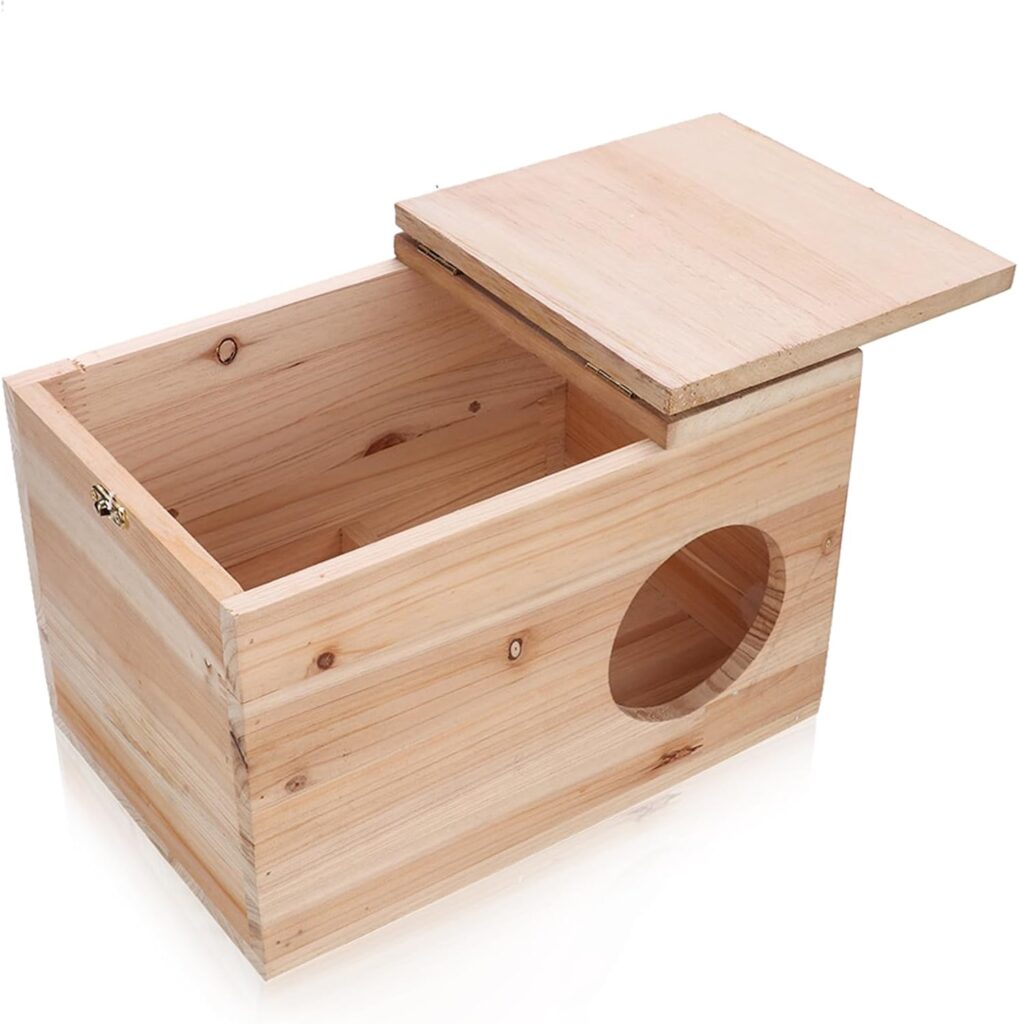
Wood Nesting House, Squirrel Nesting Box This Squirrel house is made of wood material, which is safe, strong and no toxic, wear resistant, for long term use. Click here for details

